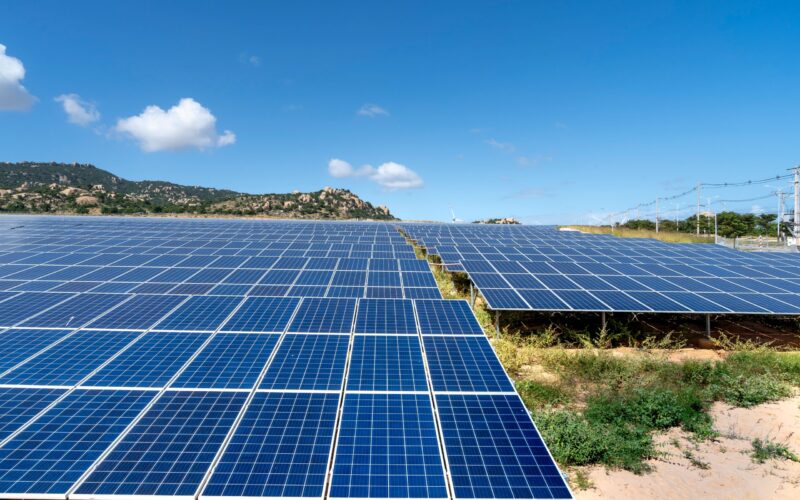Thanks to the spectral response of photovoltaic pyranometers, the calculation of the Performance Ratio is more accurate
Last update
The spectral response of photovoltaic pyranometers
Thanks to the spectral response of photovoltaic pyranometers, the calculation of the Performance Ratio is more accurate
One of the most important elements of a photovoltaic system is its performance, more commonly referred to as the performance ratio. P.R. (from P = Performance, result and R = Ratio); it defines the ratio between actual energy yield and theoretical yield; it is expressed as a percentage.
- The numerator is the actual available energy for feeding into the grid per kWp of installed system.
- The denominator is the theoretical energy available at a given time, expressed in kW/m2.
The formula in IEC 61724-1:2021 is:
PR = Yf / Yr = (Eout / P0) / (Hi / Gi,ref )
Eout : [kWh] energy output from the PV system (AC)
P0 : [kWp] array power rating
Hi : in-plane irradiation of the PV modules
Gi,ref : reference value of solar irradiance (1 000 W/m2 – STC)
The actual available energy and fed into the grid is obtained by measuring on the 3 phases current, voltage, power factor by integrating the product given by current times voltage times power factor for the time unit considered, using a network analyser or a Class A energy meter.
The theoretical energy available is just the in-plane incident solar energy of the photovoltaic modules. It can be measured with different types of pyranometers, but the results are not always the same.
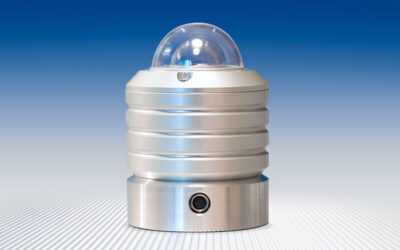
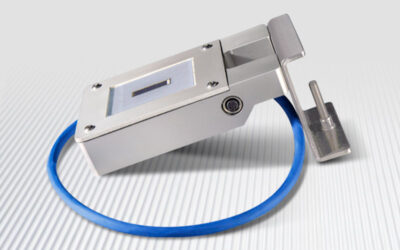
Assuming that all instruments are correctly calibrated according to the respective standards, the irradiance measurement is a quantity given by the integral of the spectral response, which is the sum of the sensitivity at the various wavelengths for which the sensor in question responds with an electrical value.
The spectral response is one of the most convincing arguments in favour of using a photovoltaic pyranometer in order to achieve accurate results in the calculation of the P.R.
Let’s start by looking at three charts of the spectral response of: a thermopile pyranometer, a photovoltaic pyranometer and of a photovoltaic pyranometer for Si amorphous modules.
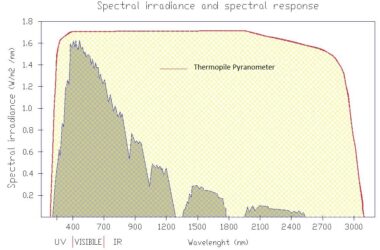
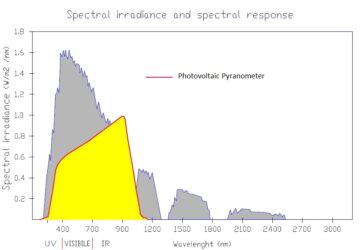
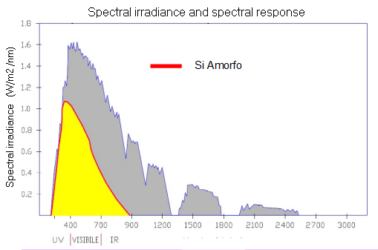
It can be seen that the thermopile pyranometer is able to record a very broad spectrum of the entire solar radiation. However, if we look at the physical-electrical characteristics of the cells that make up a photovoltaic module, we see that they produce (photovoltaic) energy when they are hit by light radiation in the 350 nm ÷1150 nm portion of the spectrum.
At this point, it is easy to understand that all solar radiation with a spectrum greater than 1200 nm is not “detected” by a PV module and is therefore not converted into electrical energy; a thermopile pyranometer detecting wavelengths up to 3000 nm would distort the Performance Ratio.
Let us take a practical example:
A sunny summer day with a not very clear and blue sky; in the morning at 11 a thermopile pyranometer measures 1000 W/m²; a photovoltaic pyranometer measures 990 W/m². In the afternoon the solar spectrum has ‘shifted’ towards the infrared at the expense of the UV portion; at 14:30 the thermopile pyranometer still reads 1000 W/m² while the photovoltaic pyranometer reads 950 W/m². Both sensors are correct because 1000 W/m² is the portion of the solar spectrum that the thermopile pyranometer ‘sees’, while ‘950 W/m² is the portion of the spectrum that the photovoltaic pyranometer ‘sees’.
What happens in these recurring cases:
As we approach afternoon, the spectrum undergoes a change not only because it decreases in intensity compared to solar noon, but also because there is a shift in its composition: the I.R. (infrared radiation) component increases.
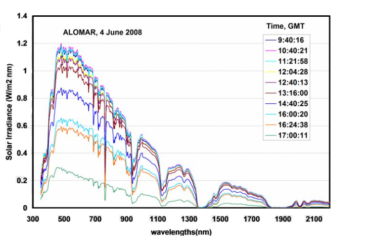
While this mutation is entirely recorded by a thermopile pyranometer, in a photovoltaic cell pyranometer only that portion of infrared that a photovoltaic cell is able to convert into energy is recorded. The result is that the P.R. resulting from calculations where there is a thermopile pyranometer is lower than that of the photovoltaic pyranometer.
Which measurement is the right one?
If we listen to the opinion of a meteorologist, then we agree on the performance ratio calculated from the data of the thermopile pyranometer; if, on the other hand, we talk to a photovoltaic operator, he will prefer the P.R. calculated from the data returned by the photovoltaic pyranometer because he is only interested in the power variations that allow a photovoltaic conversion to be compared with the output power of his photovoltaic system. The more accurate the result obtained from the P.R. calculation, the more certain he will be able to detect performance drops and possible malfunctions.
The deviation between the two P.R.’s calculated with the two types of pyranometers cannot be improved by applying a fixed multiplication coefficient between 0 and 1, as it does not take into account variations in the solar spectrum. The solar spectrum changes depending on the height of the sun (and therefore also on the latitude) and also throughout the day, although to a lesser extent.
This is not a new argument or a new hypothesis. If we think about it, radiometers with a very selective sensitivity are used to measure UV (from 210nm to 350nm), and radiometers with a selective sensitivity from 750nm onwards are used to measure IR (from 750nm). Similarly then, in order to obtain an accurate calculation of the Performance Ratio and to understand if the system is achieving a lower or higher performance than expected, the choice must fall on a good photovoltaic cell sensor.
Nevertheless, thermopile pyranometers have the advantage that their measurement is stable over several years. I would conclude by saying that if stability is needed over the years, I would suggest thermopile pyranometers; if, on the other hand, more accurate results are needed in calculating the P.R., I would choose photovoltaic cell pyranometers (or irradiance sensors), knowing, however, that in order to maintain that accuracy, they need to be calibrated every two years. However, current regulations indicate that all these sensors need to be calibrated every two years.

